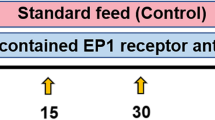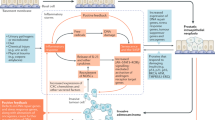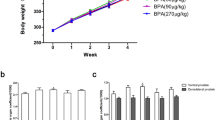Abstract
In mice fed a diet supplemented with red clover isoflavones the prostatic epithelium displays a significant increase in the production of estrogen receptor β and the adhesion protein E-cadherin but a decrease in transforming growth factor β1. These proteins are estrogenically-induced markers of proliferation, maintenance of histological architecture, preservation of cell phenotype and reduction of the potential for neoplastic and metastatic transformation. This study suggests that red clover isoflavones represent a non-toxic dietary treatment for prostatic hyperplasia and a reduction in the potential for neoplastic transformation.
This is a preview of subscription content, access via your institution
Access options
Subscribe to this journal
Receive 4 print issues and online access
$259.00 per year
only $64.75 per issue
Buy this article
- Purchase on Springer Link
- Instant access to full article PDF
Prices may be subject to local taxes which are calculated during checkout



Similar content being viewed by others
References
Slater M et al. Detection of preneoplasia in histologically normal prostate biopsies. Prostate Cancer PD 2001 4: 92–96.
Slater M, Barden JA, Murphy CR. . Tyrosine kinase A, autonomic transmitter receptors, but not innervation, are upregulated in the aging rat prostate. Acta Histochem 2000 102: 427–438.
Slater M, Murphy CR. . Detection of apoptotic DNA damage in prostate hyperplasia using tyramide-amplified avidin-HRP. Histochem J 1999 31: 747–749.
Lian FR et al. Genistein-Induced G(2)-M Arrest, P21 (Waf1) upregulation, and apoptosis in a non-small-cell lung cancer cell line. Nutrition & Cancer 1998 31: 184–191.
Muir C et al. Cancer Incidence in 5 Continents. International Agency for Research on Cancer: Lyon 1987
Xue L et al. Induced hyperproliferation in epithelial cells of mouse prostate by a Western-style diet. Carcinogenesis 1997 18: 995–999.
Kolonel L, Hinds M, Hankin J. . Cancer patterns among migrant and native-born Japanese in Hawaii Japan Sci Soc Press Tokyo 1980 43: 327–340.
Kolonel LN et al. Role of diet in cancer incidence in Hawaii. Cancer Res 1983 43: 2397s–2402s.
Parkin D et al. Cancer Incidence in 5 Continents. International agency for research on cancer. 1992 120: 5–19.
Bergan R et al. Genistein-stimulated adherence of prostate cancer cells is associated with the binding of focal adhesion kinase to beta-1-integrin. Clin Exp Metastasis 1996 14: 389–398.
Yang CC et al. Differential tyrosine phosphorylation/activation of oncogenic proline-directed protein kinase F(A)/GSK-3alpha in well and poorly differentiated human prostate carcinoma cells. J Protein Chem 1998 17: 329–335.
Adlercreutz H, Mazur W. . Phyto-oestrogens and Western diseases. Ann Med 1997 29: 95–120.
Henderson BE, Feigelson HS. . Hormonal carcinogenesis. Carcinogenesis 2000 21: 427–433.
Ciocca D et al. The presence of an estrogen-regulated protein detected by monoclonal antibody in abnormal human endometrium. J Clin Endocrinol Met 1985 60: 137–143.
Rhodes L et al. Estradiol causes a dose-dependent stimulation of prostate growth in castrated beagle dogs. Prostate 2000 44: 8–18.
Taylor AH, Al-Azzawi F. . Immunolocalisation of oestrogen receptor beta in human tissues. J Mol Endocrinol 2000 24: 145–155.
Saunders PT. . Oestrogen receptor beta (ER beta). Rev Reproduction 1998 3: 164–171.
Pelletier G, Labrie C, Labrie F. . Localization of oestrogen receptor alpha, oestrogen receptor beta and androgen receptors in the rat reproductive organs. J Endocrinol 2000 165: 359–370.
Lau KM et al. Expression of estrogen receptor (ER)-alpha and ER-beta in normal and malignant prostatic epithelial cells: regulation by methylation and involvement in growth regulation. Cancer Res 2000 60: 3175–3182.
Gustafsson JA. . An update on estrogen receptors. Seminars in Perinatology 2000 24: 66–69.
Huggins C, Hodges C. . Studies of prostatic cancer. 1. The effects of castration as well as estrogen and androgen injection on serum phosphatases in metastatic carcinoma of the prostate. Cancer Res 1941 1: 293–297.
Robertson C et al. Induction of apoptosis by diethylstilbestrol in hormone-insensitive prostate cancer cells. J Natl Cancer Inst 1996 88: 908–917.
Ahmed M et al. High dose intravenous oestrogen (fosfestrol) in the treatment of symptomatic, metastatic, hormone-refractory carcinoma of the prostate. Int J Urol Nephrol 1998 30: 159–164.
Kim IY et al. Loss of expression of transforming growth factor-beta receptors is associated with poor prognosis in prostate cancer patients. Clin Cancer Res 1998 4: 1625–1630.
Cardillo MR et al. Transforming growth factor-beta expression in prostate neoplasia. Analyt Quan Cytol Histol 2000 22: 1–10.
Gold LI. . The role for transforming growth factor-beta (TGF-beta) in human cancer. Crit Rev Oncogenesis 1999 10: 303–360.
Royuela M et al. Transforming growth factor beta 1 and its receptor types I and II. Comparison in human normal prostate, benign prostatic hyperplasia, and prostatic carcinoma. Growth Factors 1998 16: 101–110.
Wolff JM et al. Serum concentrations of transforming growth factor-beta 1 in patients with benign and malignant prostatic diseases. Anticancer Res 1999 19: 2657–2659.
Schneider HP, Jackisch C. . Potential benefits of estrogens and progestogens on breast cancer. Int J Fertility Womens Med 1998 43: 278–285.
Tang B et al. Loss of responsiveness to transforming growth factor beta induces malignant transformation of nontumorigenic rat prostate epithelial cells. Cancer Res 1999 59: 4834–4842.
Slater M. . Dynamic interactions of the extracellular matrix. Histol Histopathol 1996 11: 175–180.
Hazan RB et al. Exogenous expression of N-cadherin in breast cancer cells induces cell migration, invasion, and metastasis [published erratum appears in J Cell Biol 2000; Apr 3 149: following 236]. J Cell Biol 2000 148: 779–790.
Nuruki K et al. E-Cadherin but not N-Cadherin expression is correlated with the intracellular distribution of catenins in human hepatocellular carcinomas. Oncol Rep 1998 5: 1109–1114.
Wijnhoven BP, Dinjens WN, Pignatelli M. . E-cadherin-catenin cell-cell adhesion complex and human cancer. Br J Surgery 2000 87: 992–1005.
Cohen MB et al. Cellular adhesion molecules in urologic malignancies. Am J Clin Pathol 1997 107: 56–63.
Bussemakers MJ et al. Complex cadherin expression in human prostate cancer cells. Int J Cancer 2000 85: 446–450.
Blaschuk OW, Munro SB, Farookhi R. . E-cadherin, estrogens and cancer: is there a connection? Can J Oncol 1994 4: 291–301.
Slater M. . Mitochondrial DNA damage assessment using fluorescence microscopy quantitation. J Histotechnol 1999 22: 17–21.
Slater M, Murphy CR. . Thrombospondin is sequentially expressed and then de-expressed during early pregnancy in the rat uterus. Histochem J 1999 31: 471–475.
Slater M, Murphy CR. . Differential expression of insulin-like growth factors in the uterine epithelium and extracellular matrix during early pregnancy. Matrix Biol 1999 18: 579–584.
Dalu A et al. Genistein, a component of soy, inhibits the expression of the EGF and ErbB2/Neu receptors in the rat dorsolateral prostate. Prostate 1998 37: 36–43.
Kyle E et al. Genistein-induced apoptosis of prostate cancer cells is preceded by a specific decrease in focal adhesion kinase activity. Mol Pharmacol 1997 51: 193–200.
Author information
Authors and Affiliations
Corresponding author
Rights and permissions
About this article
Cite this article
Slater, M., Brown, D. & Husband, A. In the prostatic epithelium, dietary isoflavones from red clover significantly increase estrogen receptor β and E-cadherin expression but decrease transforming growth factor β1. Prostate Cancer Prostatic Dis 5, 16–21 (2002). https://doi.org/10.1038/sj.pcan.4500546
Received:
Accepted:
Published:
Issue Date:
DOI: https://doi.org/10.1038/sj.pcan.4500546
Keywords
This article is cited by
-
Oestrogens and oestrogen receptors in prostate cancer
SpringerPlus (2016)
-
Estrogen receptor alpha gene polymorphisms and risk of prostate cancer: a meta-analysis involving 18 studies
Tumor Biology (2014)



